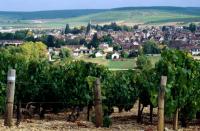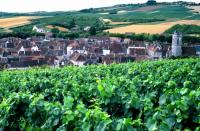Vineyard of Chablis and the grand Auxerrois
The Chablis vineyard The Chablis vineyard occupies the slopes which border the
valley of the Serein. It is an undulating region whose hilltops are very often
wooded. The production of the Chablis vineyard covers about twenty
villages. The Chablis vineyard occupies the slopes which border the
valley of the Serein. It is an undulating region whose hilltops are very often
wooded. The production of the Chablis vineyard covers about twenty
villages.→ The soil : The stony, clay-limestone ground, belongs geologically (link to the "terroir" section) to the Jurassic and the Kimmeridge periods is the most frequently found stratum. → Climate : Summers are hot, winters long and severe. The levels of sunshine and rainfall vary considerably from one year to another, making the quality and quantity of each vintage extremely vulnerable. Another problem is spring frosts, which have long been a dreaded threat to the harvests From March to May the young shoots are particularly vulnerable and the history of Chablis is punctuated by disastrous years. Since the 1960s, various protection processes have been set up (small heaters and sprinklers). Expensive and restrictive, these techniques are now effective and contribute to stabilising production levels and to protecting vine growers from the unpredictable climate. → The grape variety: This is the land Chardonnay flourishes in best (Link to "grape variety" section), the only grape variety authorised to produce all the white wines of the Chablis vineyard. This vineyard is very famous and Chablis has for many years been synonymous with great dry white wine, worldwide. → The appellations : The Chablis vineyard has 4 levels of appellation : • Chablis Grand Cru • Chablis Premier Cru • Chablis • Petit Chablis The Grand Auxerrois vineyards The
Grand Auxerrois vineyard is a group of ancient vineyards, which produce a whole
range of Bourgogne regional appellations. The majority of these Bourgogne
appellations are identified by the name of the vineyard or the village of
production. The
Grand Auxerrois vineyard is a group of ancient vineyards, which produce a whole
range of Bourgogne regional appellations. The majority of these Bourgogne
appellations are identified by the name of the vineyard or the village of
production.• Auxerrois: Located immediately to the south and south east of the town of Auxerre, this vineyard covers ten villages. • Tonnerrois: This vineyard is in the valley of the Armançon near the town of Tonnerre. • Vézelien: To the south of the department, the Vézelay vineyard covers the terroirs of the villages of Vézelay, Asquins, Saint-Père and Tharoiseau. • Jovinien: Right in the north of the department, the Vézelien vineyard overlooks the town of Joigny, on the banks of the Yonne. → Soil The main appellations of this vineyard (Irancy, St Bris, etc.) are situated on hillsides of light Upper Oxfordian limestone dominating the valley of the Yonne. → The climate The climate is very much like that of Chablis: semi-continental, relatively free from Atlantic influences, with long cold winters, wet springs and quite hot, sunny summers. The greatest risks are late frosts and hailstorms. → The grape variety: The wines are produced from Bourgogne grape varieties: Chardonnay and Aligoté for whites, Pinot Noir and Gamay for reds. (link to “grape variety” heading) Other types . whites: Sauvignon (introduced more recently) . reds: César (this variety is sometimes blended with Pinot Noir to make the Irancy appellation) → The appellations: • BOURGOGNE CHITRY • BOURGOGNE CÔTE SAINT-JACQUES • BOURGOGNE CÔTES D'AUXERRE • BOURGOGNE COULANGES-LA-VINEUSE • BOURGOGNE ÉPINEUIL • BOURGOGNE TONNERRE • BOURGOGNE VÉZELAY • CREMANT DE BOURGOGNE • IRANCY • SAINT-BRIS |
Nessun commento:
Posta un commento